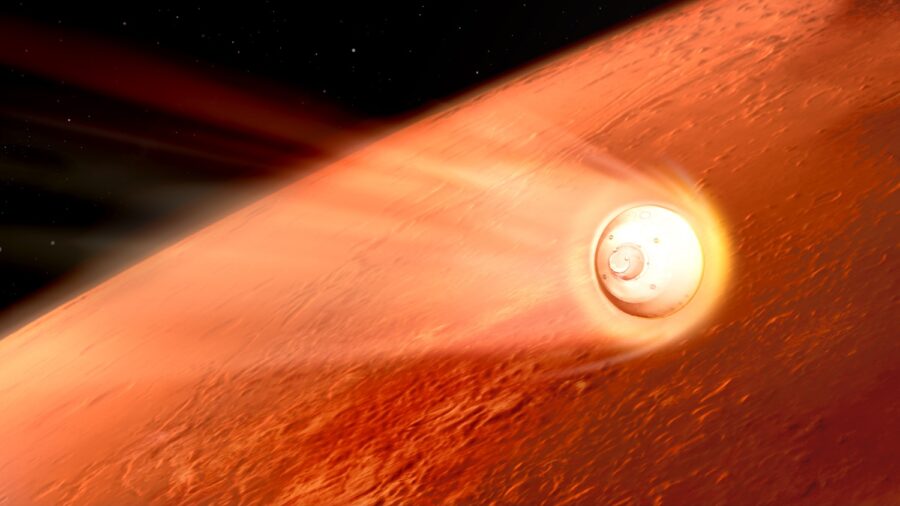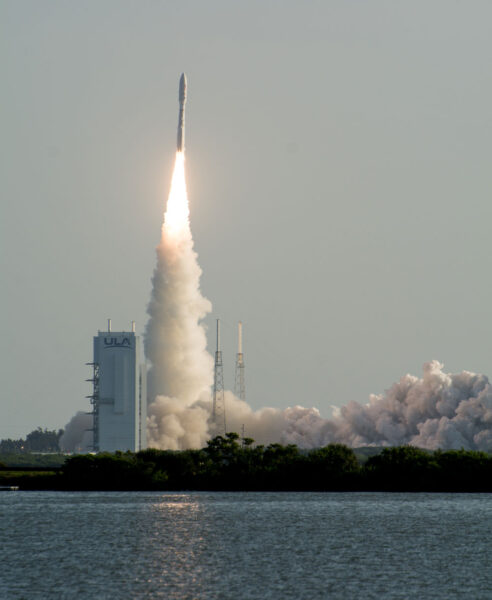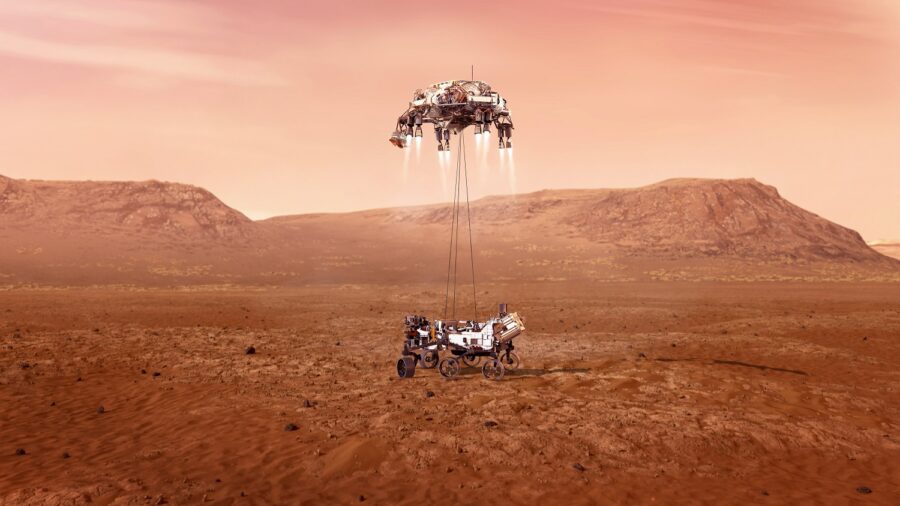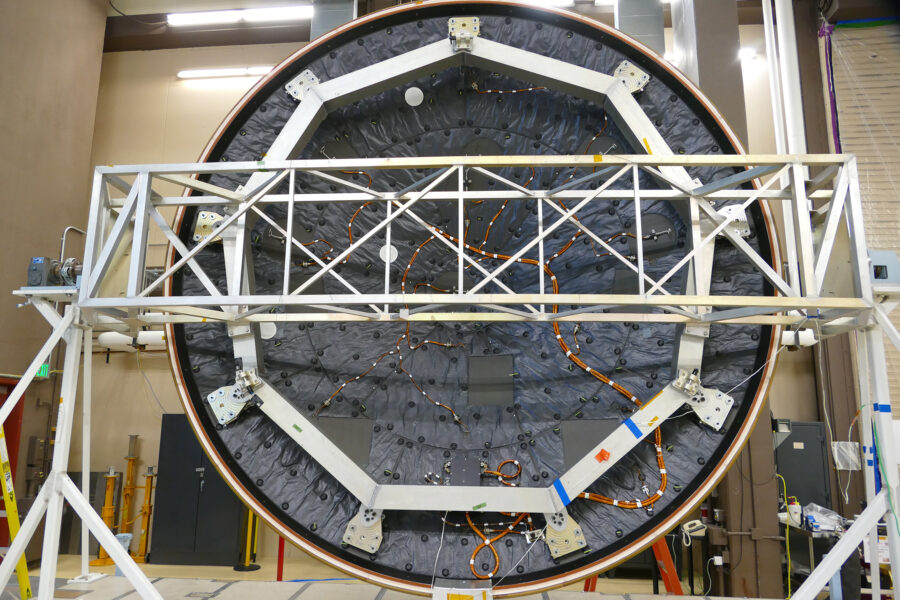NASA’s Perseverance rover is set to land on Mars tomorrow in a complex but well-tested procedure — its very own “seven minutes of terror.”

JPL-Caltech
And now, there are three! Last week, the United Arab Emirates’ Hope probe and China’s Tianwen 1 mission arrived in orbit around the Red Planet. Tomorrow, NASA’s Perseverance rover will attempt to replicate the 2011 sky-hook landing pioneered by the Curiosity Rover.
Perseverance is set to land in Jezero crater on Thursday, February 18th at 3:55 p.m. EST (20:55 UT). After a 6½-month journey, Perseverance is racing across the final million miles. But before it can land, the spacecraft first has to complete a complicated Entry, Decent, and Landing (EDL) approach and arrival sequence. Weighing in at 1,025 kilograms (2,260 pounds), Perseverance will be the largest payload ever to land on Mars.

Kirby Kahler (@krkphotog)
Perseverance shares many similarities with its look-alike predecessor, Curiosity, such as nuclear power. It also incorporates lessons learned, such as aluminum wheels that are narrower in width and larger in diameter than Curiosity's, with twice the tread in a curved shape that's designed to be more resistant to wear-and-tear
There are also a number of innovations specific to this mission. During landing, the spacecraft will use the new onboard hazard avoidance system: The Lander Vision System (LVS), which is equipped with Terrain-Relative Navigation that enables it to compare what it sees in real-time during descent to preloaded maps.
Once it lands, Perseverence will more than prove its own identity with brand-new instruments, some specifically designed for future exploration and others to find signs of life no Mars. Perseverance will attempt to perform oxygen production on Mars using the MOXIE experiment, and it brings a Raman spectrometer called SHERLOC to scan for organic and water-altered materials. Finally, Perseverance includes the first-ever helicopter set to fly on Mars, named Ingenuity.
Unlike Curiosity, Perseverance will specifically look to address the question of past life on Mars, and will collect and cache samples for a future sample return mission to retrieve sometime in the next few years.

NASA/ JPL-Caltech
The Final 24-hour Timeline
Unlike Tianwen 1, which will take its time in landing on the Red Planet, Perseverance is coming straight in for a landing. The spacecraft will hit the top of the atmosphere at 19,500 kilometers per hour (12,100 mph) and, if all goes well, land gently on the Martian surface about 7 minutes later. Light-travel time from Mars to Earth is 11 minutes, so the entire process happens autonomously — and there will be some breathless waiting before we hear whether the landing was a success.
NASA’s Deep Space Network will be listening for Perseverance to “phone home” via relay from a suite of orbiters: NASA’s Odyssey, Mars Atmospheric and Volatile EvolutioN (MAVEN), and Mars Reconnaissance Orbiter (MRO) missions, as well as the European Space Agency's Trace Gas Orbiter.
MRO will relay data in near real-time during the landing and may attempt to image the rover's descent; MAVEN will likewise record the full descent. In addition, Mars InSight could attempt to “listen” for the reverberations of the landing from 3,452 kilometers away. The Odyssey and TGO orbiters will check in on the rover at 7:27 p.m. and 9:36 p.m. EST, respectively.

NASA / JPL-Caltech
The Mars Entry, Descent, and Landing Instrumentation 2 (MEDLI2), an upgraded version of a similar system aboard Curiosity, accompanies the landing, collecting data for future missions. Installed inside the rover’s protective backshell, MEDLI2 uses 28 sensors on the heat shield’s exterior to relay information during atmospheric entry. These sensors include pressure transducers, heat flux sensors, and thermocouples. MEDLI2 will activate five hours prior to landing and relay updates every 45 minutes. Ten minutes before atmospheric interface, around the same time as the spacecraft sheds the cruise stage with the solar panels, radios, and fuel tanks used on the trip to Mars, MEDLI2 will begin continuous readings.
“Recent successful checkouts of our MEDLI2 hardware during the Mars 2020 cruise demonstrate that our system is performing as intended and has survived the initial round of harsh flight environments,” says Henry Wright (NASA-Langley Research Center) in a recent press release. “We are eager for the successful EDL of Mars 2020!”

Lockheed Martin.
During the critical 100 seconds after entry, temperatures will reach a blazing 1300°C (2400°F) outside the heat shield, though the rover will remain at room temperature. Small thrusters will adjust for any air pockets that could slightly offset the spacecraft's trajectory.
A new range trigger determines when Perseverance will deploy its supersonic parachute some 240 seconds after atmospheric entry. At this point, the spacecraft is still 11 km up but coming down quick.
Twenty seconds after the parachute is deployed, the spacecraft will jettison the heat shield. Now the hazard-avoidance system can kick in, mapping out and identifying surface features. The Lander Vision System is only operational for 25 seconds, and depending on what it reports about Perseverance's exact position, the navigation system may pick a different landing site.
The parachute detaches after the spacecraft has slowed to 200 mph. The final stage of the descent is rocket-powered, setting the lander up for the final sky-crane sequence. Just 12 seconds before touchdown, about 20 meters above the surface, the descent stage will lower Perseverance down to the ground using a set of 6.4-meter-long cables.

ESA / DLR / FU-Berlin / NASA / JPL-Caltech
You can watch the action live on NASA TV starting at 2:15 p.m. EST (19:15 UT) on February 18th. If the last Curiosity landing was any indication, we could see the first photo of the Martian surface only moments after a successful landing. We could even see images of the landing itself, relayed from the spacecraft's EDL cameras to Earth via Mars Odyssey as it makes its first pass over Jezero Crater.
One thing’s for certain: The “Great Galactic Ghoul of Mars,” which is said to have a taste for Earth-built spacecraft, isn’t invited to the show tomorrow. Get set for a wild ride for Perseverance, as the climactic big-ticket event for “Mars Season 2021” begins.
 1
1









Comments
Krukarius
February 17, 2021 at 5:15 pm
I am curious of the detailed pictures of the Martian sky
http://www.mkrgeo-blog.com/what-is-the-colour-of-martian-sky/
You must be logged in to post a comment.
You must be logged in to post a comment.